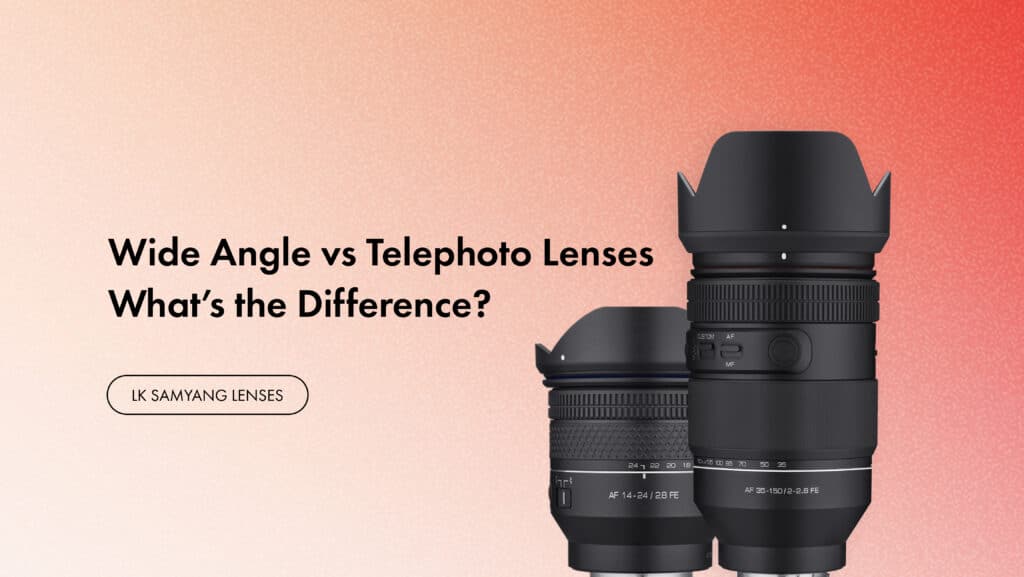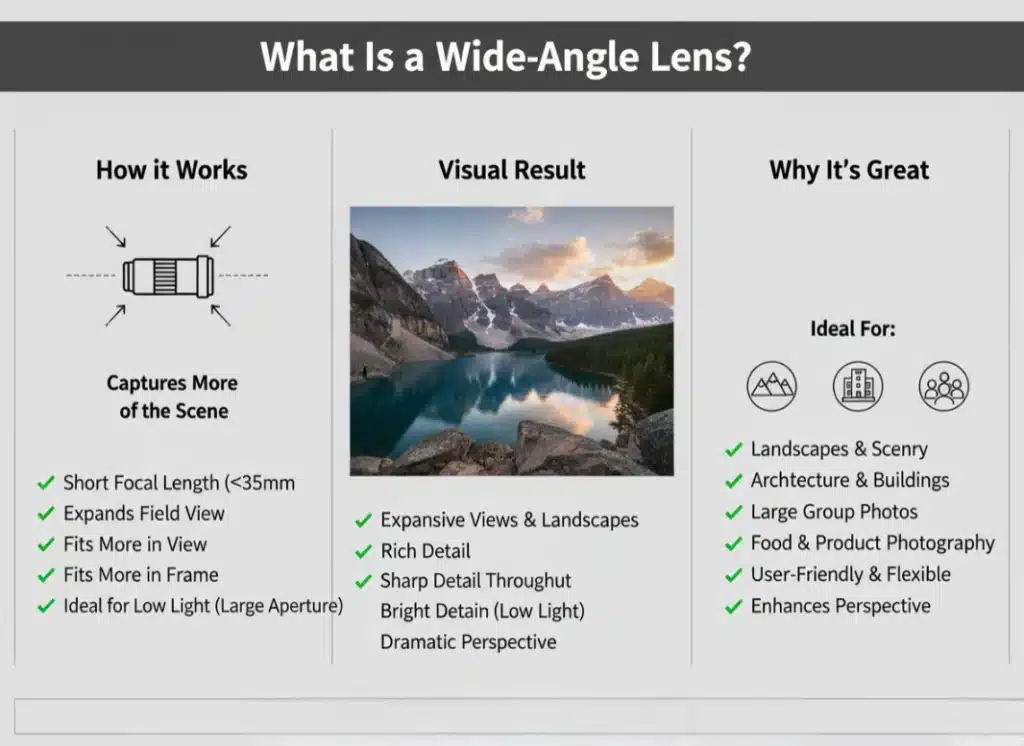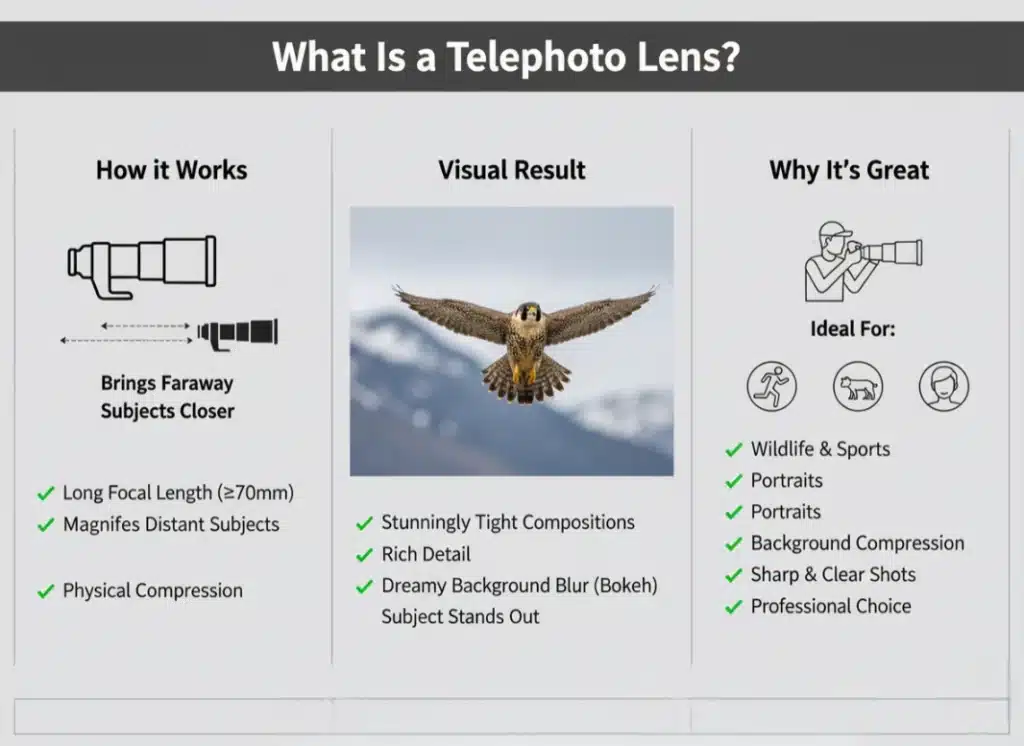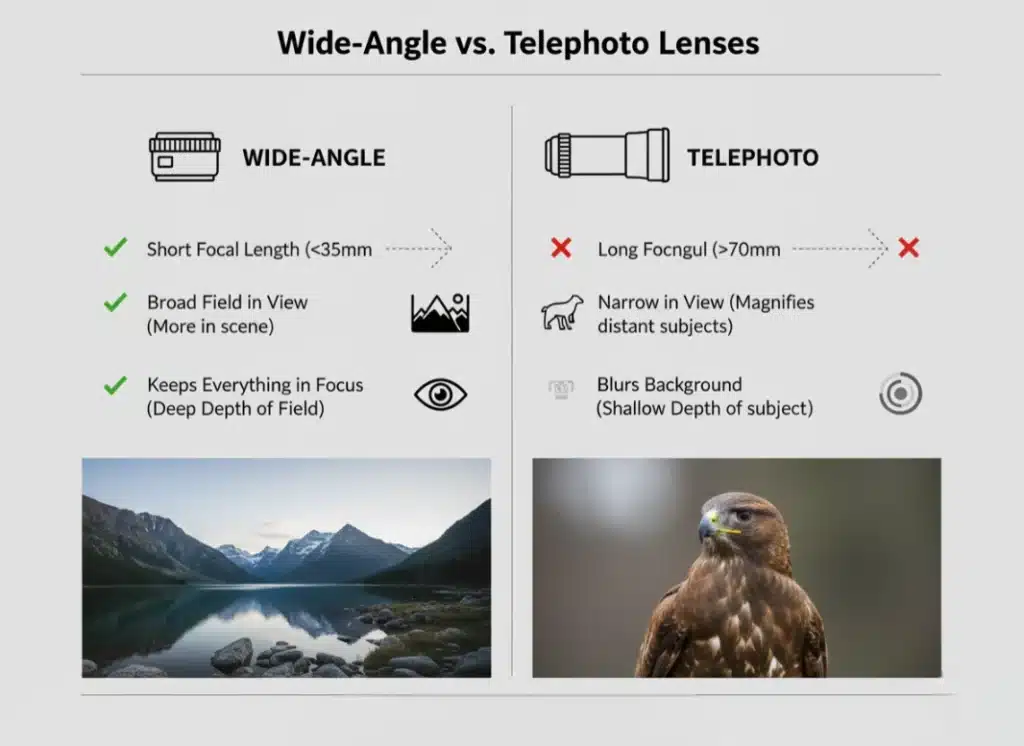
Wide Angle vs Telephoto Camera Lens – What’s the Difference?
Ever wonder what really makes a photo eye-catching? It’s not just the camera itself, but the lens that really tells the story. Camera lenses are what make the magic happen, whether you’re shooting wide-open landscapes or close-up portraits. Ultimately, they transform vision into unforgettable imagery.Selecting the right photography lens is crucial in photography. Your lens defines perspective, sharpness, and creative possibilities in every photo you take, whether you’re capturing outdoor landscapes, close-up portraits or filming smooth video recording. Understanding lens types matters.The two main lens categories, wide angle vs telephoto camera lens , give very different results. Therefore, learning about wide angle vs telephoto camera lens choices helps you create better final images. It also saves you from wasting money on a lens that doesn’t suit your camera mount.
Additionally, for photographers in Pakistan, finding the best lens price in Pakistan and original brands like LK Samyang best lens makes your selection even better. Let’s break down what sets these lenses apart and see how they fit into common photography tasks.
What Is a Wide-Angle Lens?

A wide-angle lens has a short focal length, usually under 35mm. Consequently, it allows you to capture more of the scene in a single frame. This makes it ideal for landscape photography, architectural shots, and large group photos.Wide-angle lenses for Sony or Canon cameras expand the field of view to fit more content. With a larger aperture, they brighten your images, which is perfect for low-light scenes.
Additionally, if you’re serious about food photography or product photography, a sharp wide-angle lens will provide beautiful detail and an interesting perspective. Many new creators start with wide-angle because it’s user-friendly and flexible.
Tip: Landscape photographers often use focus stacking with wide-angle lenses to keep every element, from foreground to background, perfectly sharp in their shots.
What Is a Telephoto Lens?

Want to get closer to your subject without actually moving? A telephoto lens is what you need. These lenses, usually 70mm or longer, bring faraway things right up close in your photos. That makes them great for shooting animals, sports, and even portraits.
Whether you’re shooting on Nikon, Canon, or Sony, telephoto lenses deliver stunningly tight compositions, rich detail, and that dreamy background blur everyone loves. Similarly, their longer build gives you beautiful background compression, making your subject pop effortlessly.
Long focus lenses are a bit heavier than wide-angle ones, but they’re super useful when you need to get clear shots of things that are far away. If you’re in Pakistan, comparing prices for zoom lenses can help you find the perfect lens according to your creative style without breaking the bank.
Key Differences Between Wide-Angle and Telephoto Lenses

Wide angle vs telephoto camera lens have unique characteristics that affect your images significantly. Clearly, knowing their differences lets you pick the right tool for each photography style.
Focal Length and Field of View
Wide-angle lenses have a short focal length, which is normally less than 35mm. That is, you can capture more of the scene in your shot without having to move back. The field of view is broad, hence they are most suitable in fields of expansive scenery, group photography, or taking pictures of buildings.
Telephoto lenses work the opposite way, with focal lengths starting at 70mm or higher. This gives you a narrower view and makes far-off things look bigger. Telephoto lenses are good if you’re shooting wildlife, sports, or portraits where you want to get close. Picking between wide angle and telephoto really depends on how much you want to squeeze into your picture.
Depth of Field and Background Blur
Wide-angle lenses produce a deeper depth of field. This means most of your scene, from foreground to background, remains in focus. This feature is ideal for landscape and travel photography, where sharp detail across the image is important.
Meanwhile, telephoto lenses provide a shallow depth of field, resulting in pronounced background blur. This effect is especially noticeable at wide aperture settings. The separation helps bring your subject forward, adding focus and drama, particularly for portrait photography. Knowing which style you need helps you create either crisp, all-in-focus images or beautifully blurred backgrounds.
Image Compression and Perspective
Wide-angle lenses make things look farther apart and spaces seem bigger. Because of this, objects in the front look way bigger than’s in the back. This can make for impressive, dramatic photos, but sometimes things look a little distorted around the edges.
On the other hand, telephoto lenses squeeze the scene by bringing the background and foreground closer. This makes the picture look flat and creates a nice, real look for portraits or sports photos. The squeeze also helps make your subject stand out, so you get sharper images. It helps make product photos and nature shots look pro.
Size, Weight, and Handling
Wide-angle lenses are usually small, light, and easy to pack. This makes them great for travelling and taking pictures on the street. Because they’re small, they’re easy to hold and quick to put on your camera. You can move fast and take pictures without a lot of planning with these lenses.
Telephoto lenses are larger and heavier as they have an additional amount of glass elements to gain them more magnification. However, they might need extra help as a tripod or video recording of a long session. Lens size, convenience and stability are factors to consider when choosing the one that suits your style and comfort.
Types and Common Use Cases
Let’s see how wide-angle and telephoto lenses compare in some common types of photography. Your lens choice isn’t just about the equipment. It’s about what you want to photograph, where you’ll be, and how you want things to look. Different forms of photography work best with a specific lens.
Wide-Angle Lenses (14mm-35mm):
1. Landscape Photography: Capturing the grand scale of a scene.
2. Architecture & Interiors: Fitting entire buildings or rooms into the frame.
3. Astrophotography: Capturing wide views of the night sky.
4. Group Shots: Ensuring everyone is included in a tight space.
Telephoto Lenses :
Portrait Photography: Creating beautiful background blur and flattering subject perspective.
Wildlife & Sports: Photographing distant subjects without disturbing them.
Product Photography: Achieving a true, non-distorted representation of an object.
Detail Shots: Isolating specific elements in a scene, such as in close-up food photography.
Wide-Angle vs Telephoto camera Lens for Photography Types
We will now examine the outcome of the wide angle vs telephoto camera lens debate when it comes to some of the most popular genres. It is not only a question of your equipment but what you shoot, where you shoot, and how you make your vision come true. Both styles have an advantage in a certain lens. Different forms of photography work best with a specific lens.
Landscape Photography
For landscapes, the goal is often to capture an expansive vista, which is where a wide-angle lens shines. Indeed, it creates depth by emphasizing the foreground, so getting close to a strong foreground element makes the image engaging and immerses the viewer in the scene. While a telephoto lens can isolate a specific detail or use its compression effect on distant mountains, a wide lens remains the top choice for grand landscapes.
A perfect example is the LK Samyang AF 14-24mm F2.8 FE. This great wide-angle zoom lens is super sharp throughout its zoom range. It’s ideal if you’re into taking photos of the night sky or breathtaking landscapes with your Sony camera. It helps you squeeze a lot into one shot, so you can record panoramic scenes and those special little details when you’re out in nature.
Portrait Photography
Telephoto lenses shine in portrait photography. Their long focal lengths create smooth background blur and beautifully isolate the subject. The LK Samyang AF 85mm F1.4 FE II lens is a popular choice for portraits thanks to its wide lens opening, creamy bokeh, and razor-sharp detail.
Another outstanding example is the AF 135mm F1.8 FE. This telephoto prime camera lens offers a longer reach, exceptional subject separation, and incredibly soft background blur. Moreover, its fast aperture is perfect for creating professional-grade portraits with striking clarity—whether you’re shooting on Sony, Canon, or Nikon systems.
Travel and Street Photography
Wide-angle lenses are great for travel and street photography. They’re light and easy to bring with you, plus they let you squeeze entire scenes or big buildings into one picture. The LK Samyang AF 24mm F2.8 FE is a solid pick. It’s small and gives you a wide view, so it’s perfect for walking around cities and taking quick travel photos. Also, it focuses fast and stays sharp in different light, which means you can easily grab those bright city scenes, busy streets, and cool building details.
Another good choice is the AF 35mm F1.4 P FE. This lens has a wide opening, which is great for taking beautiful night shots and creating depth in your photos. It also has a flexible focal length, so it’s perfect for both portraits and capturing detailed street scenes. Both of these lenses for Sony cameras are easy to carry and have bright f-stops, making them great companions for travel and street photography.
How to Choose the Right Lens for Your Photography Style?
Choosing between a wide angle and a telephoto lens is easier when you define your priorities. First, decide if you need to capture broad scenes, close-up details, or action at a distance. Look at the Lk samyang site to choice better fit your budget. Compare features like aperture, mount type, handling options, and compatibility with your camera system (Sony, Nikon, Canon). Finally, always check for warranty, customer reviews, and after-sales support before buying. Starting your search at the LK Samyang best lens collection is smart—they deliver reliable quality for every genre.
Final Verdict – Which One Should You Get?
Wide angle vs telephoto camera lens offer distinct creative choices. If you’re drawn to open spaces, architecture, travel, or all-in-one shots, pick a wide-angle lens for flexibility and easy use. For portraits, wildlife, sports, and product photography, telephoto lenses create polished, professional results. Take note of your camera mount, intended use, and budget before buying. In conclusion, when purchasing in Pakistan, ensure that you do the research on the prices of the lenses in order to get the best out of your money. Using original LK Samyang lenses will guarantee the quality of the image, dependability and consistency in every photo shoot.
FAQs
Should I get a wide-angle or telephoto lens?
It is based on your style of shooting. Lenses with a wide angle are ideal in landscapes and architecture, and telephotos are ideal in portraits and for distant objects. Make the selection according to what you desire to capture and the aspect that you wish to take.
Is a zoom lens better than a wide lens?
Not necessarily. A zoom lens offers flexibility to adjust focal lengths, while a wide-angle lens captures more of the scene. Zoom lenses are versatile; wide lenses are best for dramatic, expansive shots.
What is the disadvantage of a telephoto lens?
Tele lenses are bulky, cost more and are more difficult to stabilize. They also decrease depth of field and cannot always operate well in low light without support or using a fast aperture.
What is a wide-angle lens used for?
The wide-angle lens is appropriate for landscape, interior, and architecture. It takes up more space per frame and thus makes the spaces look bigger and the images have depth and drama.